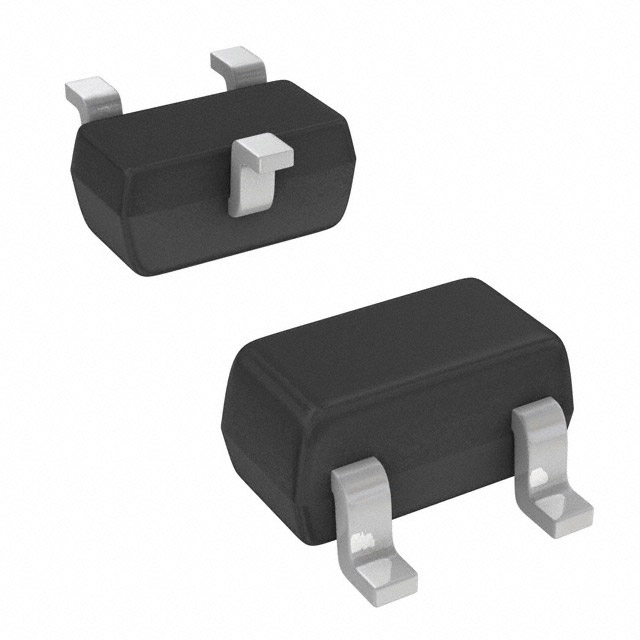Consulte las especificaciones para obtener detalles del producto.

BAV99T Diode: Encyclopedia Entry
Introduction
The BAV99T diode is a crucial component in electronic circuits, belonging to the category of small signal diodes. This entry provides an overview of the BAV99T diode, including its basic information, specifications, detailed pin configuration, functional features, advantages and disadvantages, working principles, application field plans, and alternative models.
Basic Information Overview
- Category: Small Signal Diode
- Use: The BAV99T diode is commonly used in applications requiring signal switching, clipping, and clamping.
- Characteristics: It exhibits low forward voltage drop, high switching speed, and low leakage current.
- Package: SOT-23 package
- Essence: The BAV99T diode is essential for managing signal flow and voltage regulation in electronic circuits.
- Packaging/Quantity: Typically available in reels with quantities ranging from hundreds to thousands.
Specifications
- Maximum Continuous Forward Current: 200 mA
- Reverse Voltage: 70 V
- Forward Voltage Drop: 0.715 V at 10 mA
- Reverse Recovery Time: 4 ns
Detailed Pin Configuration
The BAV99T diode has a standard SOT-23 package with three pins: 1. Pin 1: Anode of Diode 1 2. Pin 2: Common Cathode 3. Pin 3: Anode of Diode 2
Functional Features
- High-speed switching capability
- Low forward voltage drop
- Low reverse leakage current
- Compact SOT-23 package for space-constrained designs
Advantages and Disadvantages
Advantages
- Fast switching speed
- Low power dissipation
- Small form factor
- Suitable for high-density circuit designs
Disadvantages
- Limited maximum current handling capacity
- Susceptible to thermal runaway under high currents
Working Principles
The BAV99T diode operates based on the principles of semiconductor junction behavior. When forward-biased, it allows current flow with minimal voltage drop. In the reverse-biased state, it exhibits low leakage current.
Detailed Application Field Plans
The BAV99T diode finds extensive use in various applications, including: - Signal switching in audio amplifiers - Overvoltage protection in sensor interfaces - Signal rectification in communication systems - Voltage clamping in power supply circuits
Detailed and Complete Alternative Models
Several alternative models to the BAV99T diode include: - 1N4148: A general-purpose diode with similar characteristics - BAT54S: Schottky diode with dual common cathode configuration - BAV70: Dual diode with complementary characteristics
In conclusion, the BAV99T diode serves as a critical component in electronic circuits, offering fast switching capabilities and low forward voltage drop. Its compact size and versatile applications make it a popular choice for designers seeking efficient signal management solutions.
Word Count: 410
Enumere 10 preguntas y respuestas comunes relacionadas con la aplicación de BAV99T en soluciones técnicas
What is BAV99T?
- BAV99T is a dual surface mount switching diode with two diodes connected in series and is commonly used in electronic circuits for signal processing and switching applications.
What are the typical applications of BAV99T?
- BAV99T is commonly used in high-speed switching, general-purpose rectification, and signal demodulation in various technical solutions.
What is the maximum forward voltage of BAV99T?
- The maximum forward voltage of BAV99T is typically around 1V at a forward current of 100mA.
What is the reverse breakdown voltage of BAV99T?
- The reverse breakdown voltage of BAV99T is typically around 75V.
Can BAV99T be used for low-level signal detection?
- Yes, BAV99T can be used for low-level signal detection due to its low leakage current and fast switching characteristics.
What is the power dissipation of BAV99T?
- The power dissipation of BAV99T is typically around 225mW.
Is BAV99T suitable for high-frequency applications?
- Yes, BAV99T is suitable for high-frequency applications due to its fast switching speed and low capacitance.
What are the temperature specifications for BAV99T?
- BAV99T is typically rated for operation within a temperature range of -55°C to 150°C.
Can BAV99T be used in voltage clamping applications?
- Yes, BAV99T can be used in voltage clamping applications due to its ability to handle transient overvoltage conditions.
Are there any alternative components to BAV99T for similar applications?
- Yes, some alternative components to BAV99T include 1N4148, 1N914, and BAT54S, which can be used for similar applications in technical solutions.

